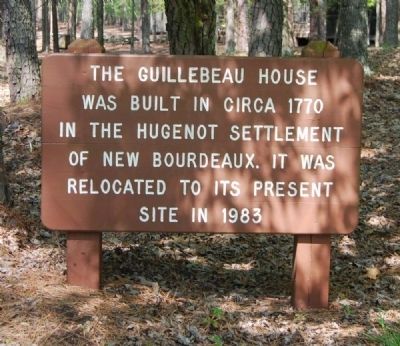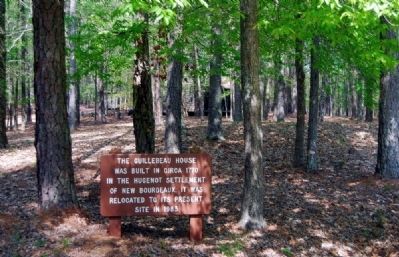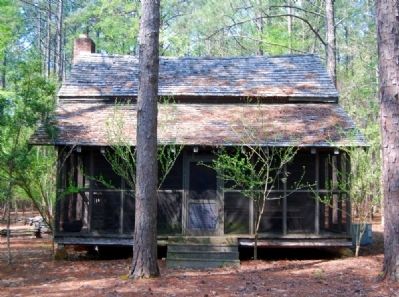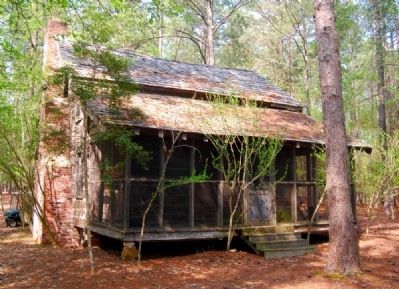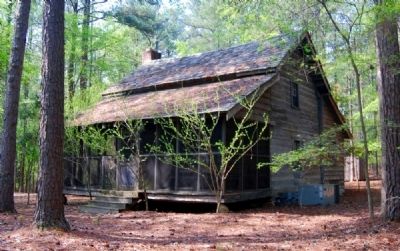McCormick in McCormick County, South Carolina — The American South (South Atlantic)
The Guillebeau House
was built in circa 1770
in the Huguenot settlement
of New Bordeaux. It was
relocated to its present
site in 1983.
Erected by South Carolina State Park Service.
Topics. This historical marker is listed in this topic list: Notable Buildings. A significant historical year for this entry is 1770.
Location. 33° 52.867′ N, 82° 25.85′ W. Marker is in McCormick, South Carolina, in McCormick County. Marker is on Resort Drive, on the right when traveling south. Marker is located near the cabin in Hickory Knob State Park. Touch for map. Marker is in this post office area: Mc Cormick SC 29835, United States of America. Touch for directions.
Other nearby markers. At least 10 other markers are within 5 miles of this marker, measured as the crow flies. General Elijah Clark (approx. 2.4 miles away in Georgia); Dooly Spring (approx. 2.7 miles away in Georgia); Tory Pond (approx. 2.8 miles away in Georgia); New Bordeaux (1764) (approx. 3 miles away); Edmunds Family History / Samuel Calhoun Edmunds (approx. 3.1 miles away); New Bordeaux Worship Site (approx. 3.9 miles away); Welcome to Baker Creek State Park (approx. 4.2 miles away); John De La Howe School Lethe Farm Trail (approx. 4.3 miles away); John De La Howe Forest (approx. 4.3 miles away); Andre Guillebeau (approx. 4˝ miles away). Touch for a list and map of all markers in McCormick.
Also see . . .
1. Guillebeau House. The Guillebeau House is a good example of Southern eighteenth-century pioneer construction. (Submitted on April 22, 2011, by Brian Scott of Anderson, South Carolina.)
2. A History of New Bordeaux. In 1761, The Bounty Act was a direct result of the French and Indian War (1756-1759 in the colonies) and the Cherokee War (1760) in South Carolina. (Submitted on April 22, 2011, by Brian Scott of Anderson, South Carolina.)
Additional commentary.
1. Guillebeau House
The Guillebeau House is a good example of Southern pioneer construction. Built on the double pen house plan developed extensively in the South, the house has one exterior chimney and two front entrances. Shed-roof porch across front, originally open, has been enclosed at either end to provide additional rooms. The original floor plan is still intact and consists of three rooms in front of three rooms. The second floor also has three rooms which were completed shortly after the Revolutionary War. At one time a dining room wing was attached at rear but is not believed to have been original.
Several of the large logs which provided original foundation supports are still intact. Walls are constructed of hand-hewn logs with mortise-and-tenon joints. Filling between logs.
Medium gable roof features typical pioneer construction method in which plates are used to support rafters which in turn support purl ins. Roof was covered with wooden shingles.
Original exterior end chimney is laid in Flemish bond in first two stages. In third stage, brickwork is done in all stretcher pattern with alternating header-stretcher design in comers.
The family cemetery is included in the acreage nominated. It is maintained by the Guillebeau descendants.
Significance
With the revival of the Reformed Church in France by such leaders as Antoine Court, the French government enacted the vindictive Edict of 1724 which was in force until the 1787 Edict of Toleration. During this period of relentless Protestant persecution, a small group of French Huguenots led by the Reverend Jean Louis Gibert and the Reverend Pierre Boutiton petitioned George III for permission to establish a settlement in one of England's American colonies. Their petition was granted in 1763 when the Earl of Hillsborough wrote to Governor Boone of South Carolina that the king thought it advisable for the French to be established in South Carolina where their knowledge of the culture of vines and silks would be particularly useful. Hillsborough further instructed the governor to provide a "proper Township for them either upon the river Savannah or "some other Convenient river." After a long sea voyage from Plymouth, England and several months delay in Charleston and at Fort Lyttleton near Port Royal, the French settlers arrived at New Bordeaux in August 1764. Although there were several Huguenot settlements in the lowcountry, New Bordeaux was the only such settlement in the South Carolina upcountry. Andre Guillebeau (b.1739-d.1814) built this house shortly after his arrival at New Bordeaux. The house was subsequently owned by Andre's son Peter (b.1769-d.1854) and then by Peter's son Peter (b.1812-d.1891). After the death of Peter in 1891, the property went to Peter's brother, John James Guillebeau, who sold it shortly thereafter. According to Peter's will, there was a 400-acre tract surrounding the house.
Military Significance
During the American Revolution, Andre Guillebeau served in the American militia under Captain Joseph Bouchillon (also a Huguenot settler at New Bordeaux) from August 1779 - May 1782. Andre wounded in action.
Architectural Significance
The Guillebeau House is a fine physical document on 18th Century pioneer construction in the South. It remains largely unaltered. Descendants of Andre Guillebeau continue to hold family reunions in New Bordeaux every other year and are most interested in promoting the purchase and restoration of the house. Since it is the only extant Huguenot building in New Bordeaux, its preservation is extremely important to the area and the state. (Source: National Register nomination form.)
— Submitted April 22, 2011, by Brian Scott of Anderson, South Carolina.
Credits. This page was last revised on September 17, 2020. It was originally submitted on April 22, 2011, by Brian Scott of Anderson, South Carolina. This page has been viewed 1,417 times since then and 33 times this year. Photos: 1, 2, 3, 4, 5. submitted on April 22, 2011, by Brian Scott of Anderson, South Carolina.
